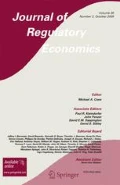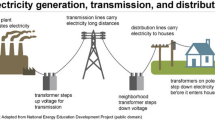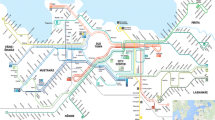Abstract
We study the impact of different regulatory designs on the cost efficiency of operators providing a public service, exploiting data from the French transport industry. The distinctive feature of the study is that it considers regulatory regimes as endogenously determined choices, explained by economic, political, and institutional variables. Our approach leans on a positive analysis to study the determinants of regulatory contract choices, which, in turn, affect the costs of operating urban public transport. Our results show that given similar network characteristics, networks operated under fixed-price contracts exert lower costs than those regulated under cost-plus contracts. This finding is in line with the theoretical prediction of new regulatory economics that fixed-price contracts provide more incentives for efficiency. Importantly, ignoring the endogeneity of contractual choices would lead to significantly underestimating the impact of contract type on cost efficiency. Our findings provide useful policy implications suggesting that the move toward more high-powered incentive schemes is indeed associated with significant cost efficiencies. Moreover, they highlight the importance of accounting for the endogeneity of regulatory contract choices.
Similar content being viewed by others
Notes
Loi n° 82-1153 du 30 décembre 1982 d’orientation des transports intérieurs.
Unlike the rest of France, the Ile-de-France region has only one authority responsible for organizing urban transport, namely “Syndicat des transports d’Ile-de-France (STIF)”. It is responsible for organizing, coordinating, and financing public transport on the behalf of the local authorities in this region. STIF takes its decisions in consultation with three transport carriers—RATP, SNCF, and OPTILE—compensating them for operating transport and the improvements they make at its request.
Loi n° 82-213 du 2 mars 1982 relative aux droits et libertés des communes, des départements et des régions.
Loi n° 83-8 du 7 janvier 1983 relative à la répartition de compétences entre les communes, les départements, les régions et l’Etat.
Loi n° 93-122 du 29 janvier 1993 relative à la prévention de la corruption et à la transparence de la vie économique et des procédures publique.
This tax is a local contribution of employers that allows to provide funding for the urban public transport. It was introduced in 1971 in Ile-de-France to meet operating and investment costs of urban transport networks. In its current form, it is imposed on both public and private sector employers with more than 9 employees within an urban transport area of a population of more than 10,000. In addition to the revenues from the sale of tickets and public subsidies, the transport allocation helps to cover the costs of urban public transport.
Veolia Environnement is an international group with activities in water provision, water sanitation, waste treatment, cleaning and sanitation services, energy services, and transport.
RATP is the operator of urban transport in Paris. It is a public company.
Within fixed-price contracts, two forms of contractual schemes can be further distinguished depending on the division of commercial risk between the private operator and local authority: gross-cost contracts and net-cost contracts. Under gross-cost contracts, the commercial risk is borne by the local authority. Local authorities collect commercial receipts and operators are reimbursed based on their expected operating costs. Under net-cost contracts, private operators carry both the industrial and commercial risk and are reimbursed based on their expected operating deficits. As the focus of the paper is on cost efficiency of the supply, we do not tackle the issue concerning informational asymmetries on the demand side and related incentive problem.
As stated in the 2015 report prepared by the French court of auditors (fr. Cour des Comptes) concerning, among others, the state of urban public transport in France, information provided by the operators to the local authority is often incomplete, erroneous, or non-explicit. This makes it difficult for the authority to analyze the effectiveness and efficiency of the management of the service delegated to the operator. Additionally, as underlined in the previous 2005 report of the French court of auditors, the control of the execution of the service undertaken by the organizing authorities and the means of expertise that they possess are still underdeveloped. The insufficiency of the reports provided by the operator to the organizing authority and the complexity of the organization of the service make the evaluation even more difficult. In addition, there are no national statistics measuring the structure and evolution of the population of passengers. This also concerns data allowing comparisons of the average consumption of their vehicles as compared to other networks.
In our empirical investigation, we perform a test to verify whether the transcendental logarithmic cost function is a good representation of the cost structure of transport operators in our study.
Please note that undertaking a robustness test by excluding the 1% top and bottom percentiles of each of the price variables, our results remain quantitatively and qualitatively largely similar to the baseline results.
Please note that we observe 29 switches of regulatory regime, with 85% concerning changes from a cost-plus to a fixed-price regime. Therefore, our results should be interpreted having in mind that predominantly switches from cost-plus to fixed-price contracts drive our estimation results.
In our analyses, we considered other political dimensions, including the role played by closeness to municipal elections or mayor’s tenure (see Coviello and Gagliaducci 2017). Our results suggest that these are not relevant dimensions in the industry studied. The results are available upon request.
In addition, in order to verify whether the transcendental logarithmic cost function gives a good representation of the cost structure of the transport operators in our sample, a likelihood-ratio test on the technology restrictions implied by a Cobb-Douglas functional form is performed. The results of this exercise lead to the rejection of these restrictions and, therefore, to retain the model presented in equation 6. The results are available upon request.
Please note that spatial dimensions do not seem to be relevant when considering regulatory contract choices in the French urban public transport. Urban transport networks are not directly neighboring and are dispersed geographically. Moreover, organizing transport authorities in France belong to an association of Transport Authorities (fr. Groupement des autorités responsables de transport). Through the association, they are aware of the contractual choices made by the remaining networks, independent of whether these are neighboring networks are not. Therefore, individual regulatory choices may rather be influenced by the general industry trends. This is in line with our results suggesting a positive trend on the choice of fixed-price rather than cost-plus contracts.
Please note that the contract governing the relationship between the local authority and transport operator specifies the characteristics of the service to be provided. This is, for instance, the case of quality.
References
Aigner, D., Lovell, C. K., & Schmidt, P. (1977). Formulation and estimation of stochastic frontier production function models. Journal of Econometrics, 6(1), 21–37.
Bajari, P., & Tadelis, S. (2001). Incentives versus transaction costs: A theory of procurement contracts. The RAND Journal of Economicsl, 32, 387–407.
Baron, D. P., & Myerson, R. B. (1982). Regulating a monopolist with unknown costs. Econometrica, 50, 911–930.
Battese, G., & Coelli, T. (1993). A stochastic frontier production function incorporating a model for technical inefficiency effects. In Working papers in econometrics and applied statistics (Vol. 69).
Becker, G. (1983). A theory of competition among pressure groups for political influence. The Quarterly Journal of Economic, 98, 371–400.
Beuve, J., Moszoro, M. W., & Saussier, S. (2019). Political contestability and contract rigidity: An analysis of procurement contracts. Journal of Economics and Management Strategy, 28(2), 316–335.
Chong, E., Huet, F., Saussier, S., & Steiner, F. (2006). Public-private partnerships and prices: Evidence from water distribution in France. Review of Industrial Organization, 29(1), 149–169.
Christensen, L. R., & Greene, W. H. (1976). Economies of scale in US electric power generation. Journal of political Economy, 84(4), 655–676.
Coase, R. H. (1937). The nature of the firm. Economica, 4(16), 386–405.
Cornwell, C., Schmidt, P., & Sickles, R. C. (1990). Production frontiers with cross-sectional and time-series variation in efficiency levels. Journal of Econometrics, 46, 185–200.
Cour des Comptes. (2005). Les transports publics urbains, Technical report.
Coviello, D., & Gagliaducci, S. (2017). Economic efficiency and political capture in public service contracts. American Economic Journal: Economic Policy, 9, 59–105.
Cowen, T., & Parker, D. (1997). Markets in the firm: A market-process approach to management. HOBART PAPERS (Book 134), Coronet Books Inc.
de Silanes, F. L., Shleifer, A., & Vishny, R. W. (1997). Privatization in the United States. The RAND Journal of Economics, 28, 447–471.
Duso, T. (2005). Lobbying and regulation in a political economy: The U.S. cellular industry. Public Choice, 122, 251–276.
EC (03/10/2017). Increasing the impact of public investment through procurement—factsheet.
Gagnepain, P., & Ivaldi, M. (2002a). Incentive regulatory policies: The case of public transit systems in France. The RAND Journal of Economics, 33, 605–629.
Gagnepain, P., & Ivaldi, M. (2002b). Stochastic frontiers and asymmetric information models. Journal of Productivity Analysis, 18(2), 145–159.
Gagnepain, P., & Ivaldi, M. (2017). Economic efficiency and political capture in public service contracts. The Journal of Industrial Economics, 65, 1–38.
GART. (2015). L’année 2013 des transports urbains.
Gautier, A., & Yvrande-Billon, A. (2013). Contract renewal as an incentive device (p. 4). Review of Economics and Institutions: An Application to the French Urban Public Transport Sector.
Greene, W. (2012). Econometric analysis (7th ed.). Upper Saddle River, NJ: Prentice Hall.
Guasch, J., Laffont, J., & Straub, S. (2007). Concessions of infrastructure in Latin America: Government-led renegotiation. Journal of Applied Econometrics, 22, 1267–1294.
Heckman, J. (1976). The common structure of statistical models of truncation, sample selection and limited dependent variables and a simple estimator for such models. Annals of Economic and Social Measurement, 5, 475–492.
Kumbhakar, S. C. (1990). Production frontiers and panel data, and time-varying technical inefficiency. Journal of Econometrics, 46, 201–211.
Kumbhakar, S., Ghosh, S., & McGuckin, J. (1991). A generalized production frontier approach for estimating determinants of inefficiency in U.S. dairy farms. Journal of Business & Economic Statistics, 9(3), 279–286.
Laffont, J.-J., & Tirole, J. (1991). The politics of government decision-making: A theory of regulatory capture. The Quarterly Journal of Economics, 106, 1089–1127.
Laffont, J., & Tirole, J. (1993). A theory of incentives in procurement and regulation. Cambridge: MIT Press.
Levin, J., & Tadelis, S. (2010). Contracting for government services: Theory and evidence from U.S. cities. The Journal of Industrial Economics, 58, 507–541.
Maddala, G. (1983). Limited-dependent and qualitative variables in econometrics. Cambridge: Cambridge University Press.
Meeusen, W., & den Broeck, J. V. (1977). Efficiency estimation from cobb-douglas production functions with composed error. International Economic Review, 18(2), 435–444.
Moszoro, M. W., & Spiller, P. T. (2019). Political contestability and public contracting. Journal of Public Economic Theory, 21, 945–966.
Ng, C. K., & Seabright, P. (2001). Competition, privatisation and productive efficiency: Evidence from the airline industry. The Economic Journal, 111(473), 591–619.
Peltzman, S. (1976). Toward a more general theory of regulation. The Journal of Law & Economics, 19(2), 211–240.
Piacenza, M. (2006). Regulatory contracts and cost efficiency: Stochastic frontier evidence from the italian local public transport. Journal of Productivity Analysis, 25, 257–277.
Pint, E. M. (1991). Nationalization vs. regulation of monopolies: The effects of ownership on efficiency. Journal of Public Economics, 44(2), 131–164.
Prager, R. (1990). Firms behavior in Franchise monopoly markets. The RAND Journal of Economics, 21, 211–225.
Roemer, J. E., & Silvestre, J. (1992). A welfare comparison of private and public monopoly. Journal of Public Economics, 48(1), 67–81.
Schmidt, P., & Sickles, R. (1984). Production frontiers and panel data. Journal of Business & Economic Statistics, 2(4), 367–374.
Stigler, G. (1971). The theory of economic regulation. The Bell Journal of Economics and Management Science, 2(1), 3–21.
Williamson, O.E. (1975). Markets and hierarchies (vol. 2630). New York
Williamson, O. (2002). The theory of the firm as governance structure: From choice to contract. The Journal of Economic Perspectives, 16, 171–195.
Yvrande-Billon, A. (2006). The attribution process of delegation contracts in the french urban transport sector: Why competitive tendering is a myth. Annals of Public and Cooperative Economics, 77(4), 453–478.
Author information
Authors and Affiliations
Corresponding author
Additional information
Publisher's Note
Springer Nature remains neutral with regard to jurisdictional claims in published maps and institutional affiliations.
We are extremely thankful to CEREMA, GART, and UTP for providing the complete database on urban public transport in France for the purpose of our research. We thank Özlem Bedre-Defolie, Tomaso Duso, Matthias Finger, Emmanuel Frot, Philippe Gagnepain, Marc Ivaldi and Stéphane Saussier, as well as audiences at conferences at EARIE, ESNIE, and the EUI conference on the Regulation of Infrastructures and two anonymous referees for their valuable comments.
Rights and permissions
About this article
Cite this article
Piechucka, J. Cost efficiency and endogenous regulatory choices: evidence from the transport industry in France. J Regul Econ 59, 25–46 (2021). https://doi.org/10.1007/s11149-020-09423-y
Accepted:
Published:
Issue Date:
DOI: https://doi.org/10.1007/s11149-020-09423-y




